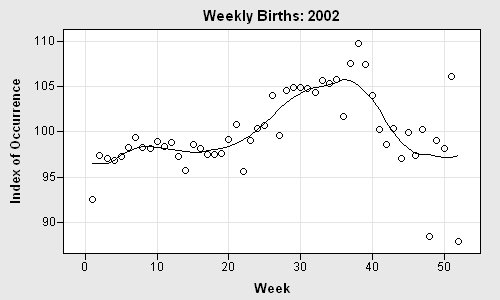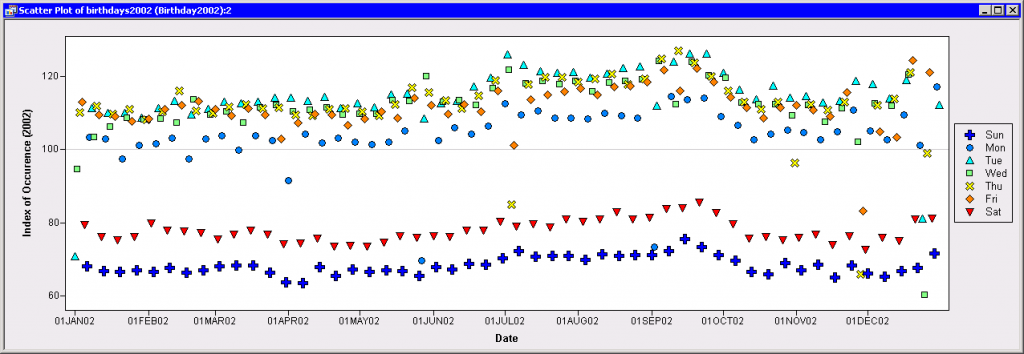Do you know someone who has a birthday in mid-September? Odds are that you do: the middle of September is when most US babies are born, according to data obtained from the National Center for Health Statistics (NCHS) Web site (see Table 1-16).
There's an easy way to remember this fact:
Q: When are most babies born?
A: After Labor day!
The following graph shows the number of weekly births in 2002, normalized so that the mean number of births is represented by 100. This is called the "index of occurrence" by researchers in the Office of Vital Statistics (Martin, et al., 2006). Notice that the peak number of births occurs in weeks 37, 38, and 39, which corresponds to September 9–29, 2002.

Other years show similar behavior, as noted in Martin, et al., 2006:
Historically, the number of births peaks during the summer, and is at its lowest during the winter.... Observed birth rates... were at their highest in September and lowest in December.
Perhaps an even more interesting phenomenon is that there is a "man-made" day-of-the-week effect, due to the large number of US deliveries that are induced or delivered by a scheduled cesarean delivery. The following graph, which is taken from the book Statistical Programming with SAS/IML Software, shows the distribution of the 4,021,726 live births in the US for the year 2002. (Click to enlarge.) You can also download the data from the book's Web site.

The shapes and colors of the markers correspond to days of the week. Most US babies are born Tuesday through Friday. Compared with the other weekdays, Mondays have fewer births. The fewest babies are born on weekends and holidays.
Martin, et al., 2006, comment on these patterns and attribute the day-of-week effect to induced labor and cesarean deliveries:
Patterns in the average number of births by day of the week may be influenced by the scheduling of induction of labor and cesarean delivery. . . . The relatively narrow range for spontaneous vaginal births contrasts sharply with that of . . . cesarean deliveries that ranged from [fewest deliveries]on Sunday to [most deliveries]on Tuesday.
The birth data also indicate a "holiday effect" in which there are fewer babies born on US holidays. In particular, in a great instance of statistical irony, there are fewer babies born on Labor Day (Monday, 02SEP2002) than would be expected for a Monday in September. Can you find the blue circle for Labor Day, 2002, near the bottom of the plot? That value is about 65% less than what would be expected for a non-holiday Monday in September.

6 Comments
Pingback: Birthdays among friends - The SAS Dummy
It seems that the most likely birthday roughly corresponds to 39 weeks or so after the holidays. I wonder if that means that egg nog induces pregnancy... (?) Perhaps it does, but only indirectly!
Pingback: The birthday controversy: Are more people born in April or September? - The DO Loop
Pingback: What’s our sign? - The SAS Dummy
Pingback: The effect of holidays on US births - The DO Loop
My wife was due to deliver near the beginning of July. Near end of June, there were some complications. The doctor said "We could wait for this to be a life threatening emergency over a holiday weekend, but let's not". July 3 it was, by planned c-section.